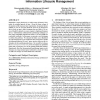Free Online Productivity Tools
i2Speak
i2Symbol
i2OCR
iTex2Img
iWeb2Print
iWeb2Shot
i2Type
iPdf2Split
iPdf2Merge
i2Bopomofo
i2Arabic
i2Style
i2Image
i2PDF
iLatex2Rtf
Sci2ools
SIGMOD
2008
ACM
2008
ACM
Query-based partitioning of documents and indexes for information lifecycle management
Regulations require businesses to archive many electronic documents for extended periods of time. Given the sheer volume of documents and the response time requirements, documents that are unlikely to ever be accessed should be stored on an inexpensive device (such as tape), while documents that are likely to be accessed should be placed on a more expensive, higher-performance device. Unfortunately, traditional data partitioning techniques either require substantial manual involvement, or are not suitable for read-rarely workloads. In this paper, we present a novel technique to address this problem. We estimate the future access likelihood for a document based on past workloads of keyword queries and the click-through behavior for top-K query answers, then use this information to drive partitioning decisions. Our overall best scheme, the document-split inverted index, does not require any parameter tuning and yet performs close to the optimal partitioning strategy. Experiments show th...
Data Partitioning Techniques | Database | Optimal Partitioning Strategy | Partitioning Improves Performance | SIGMOD 2008 |
| Added | 08 Dec 2009 |
| Updated | 08 Dec 2009 |
| Type | Conference |
| Year | 2008 |
| Where | SIGMOD |
| Authors | Soumyadeb Mitra, Marianne Winslett, Windsor W. Hsu |
Comments (0)

